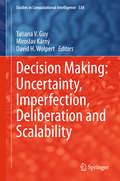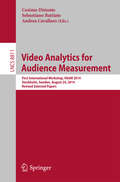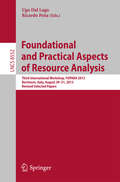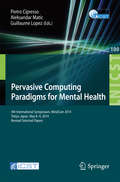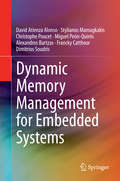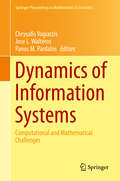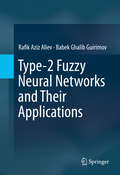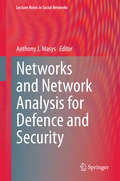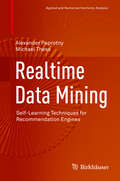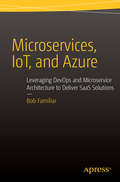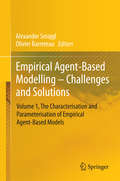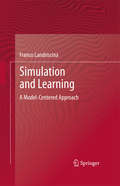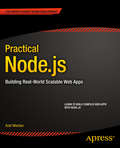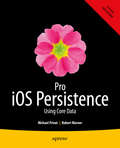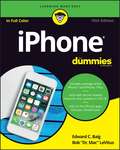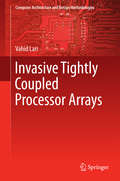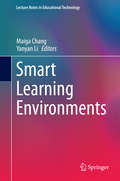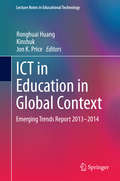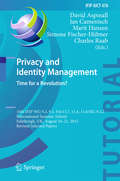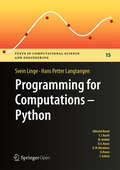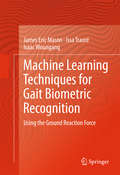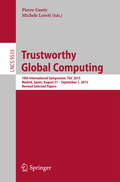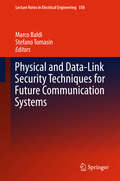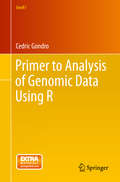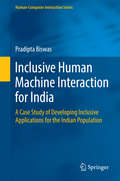- Table View
- List View
Decision Making: Uncertainty, Imperfection, Deliberation and Scalability
by Tatiana V. Guy Miroslav Kárný David H. WolpertThis volume focuses on uncovering the fundamental forces underlying dynamic decision making among multiple interacting, imperfect and selsh decision makers. The chapters are written by leading experts from different disciplines, all considering the many sources of imperfection in decision making, and always with an eye to decreasing the myriad discrepancies between theory and real world human decision making. Topics addressed include uncertainty, deliberation cost and the complexity arising from the inherent large computational scale of decision making in these systems. In particular, analyses and experiments are presented which concern: * task allocation to maximize "the wisdom of the crowd"; * design of a society of "edutainment" robots who account for one anothers' emotional states; * recognizing and counteracting seemingly non-rational human decision making; * coping with extreme scale when learning causality in networks; * efciently incorporating expert knowledge in personalized medicine; * the effects of personality on risky decision making. The volume is a valuable source for researchers, graduate students and practitioners in machine learning, stochastic control, robotics, and economics, among other elds.
Video Analytics for Audience Measurement
by Andrea Cavallaro Cosimo Distante Sebastiano BattiatoThis book constitutes the refereed contest reports of the 1st International Workshop, VAAM 2014, held in Stockholm, Sweden, in August 2014. The 10 revised full papers presented were carefully reviewed and selected from 13 submissions. The aim of this workshop is to provide an overview of state of the art methods for audience measurements in retail and Digital Signage, end-users attraction, and stimulate the creation of appropriate benchmark dataset to be used as reference for the development of novel audience measurement algorithms. Papers are invited under the following topics: demographics and modeling consumer behaviour.
Foundational and Practical Aspects of Resource Analysis
by Ugo Dal Lago Ricardo PeñaThis book constitutes the proceedings of the Third International Workshop on Foundational and Practical Aspects of Resource Analysis, FOPARA 2013, held in Bertinoro, Italy, in August 2013. The 9 papers presented in this volume were carefully reviewed and selected from 12 submissions. They deal with traditional approaches to complexity analysis, differential privacy, and probabilistic analysis of programs.
Pervasive Computing Paradigms for Mental Health
by Aleksandar Matic Guillaume Lopez Pietro CipressoThis book constitutes revised post-proceedings of the 4th International Symposium on Pervasive Computing Paradigms for Mental Health, MindCare 2014, held in Tokyo, Japan, in May 2014. The 11 full and 5 short papers presented were carefully reviewed and selected from 26 submissions for inclusion in the proceedings. The papers are organized in topical sections on recognition and assessment, mental health management, improving communication, depression, and self-applied treatments.
Dynamic Memory Management for Embedded Systems
by Dimitrios Soudris Francky Catthoor David Atienza Alonso Stylianos Mamagkakis Christophe Poucet Miguel Peón-Quirós Alexandros BartzasThis book provides a systematic and unified methodology, including basic principles and reusable processes, for dynamic memory management (DMM) in embedded systems. The authors describe in detail how to design and optimize the use of dynamic memory in modern, multimedia and network applications, targeting the latest generation of portable embedded systems, such as smartphones. Coverage includes a variety of design and optimization topics in electronic design automation of DMM, from high-level software optimization to microarchitecture-level hardware support. The authors describe the design of multi-layer dynamic data structures for the final memory hierarchy layers of the target portable embedded systems and how to create a low-fragmentation, cost-efficient, dynamic memory management subsystem out of configurable components for the particular memory allocation and de-allocation patterns for each type of application. The design methodology described in this book is based on propagating constraints among design decisions from multiple abstraction levels (both hardware and software) and customizing DMM according to application-specific data access and storage behaviors.
Dynamics of Information Systems
by Panos M. Pardalos Chrysafis Vogiatzis Jose L. WalterosThe contributions of this volume stem from the "Fifth International Conference on the Dynamics of Information Systems" held in Gainesville, FL in February 2013, and discuss state-of the-art techniques in handling problems and solutions in the broad field of information systems. Dynamics of Information Systems: Computational and Mathematical Challenges presents diverse aspects of modern information systems with an emphasis on interconnected network systems and related topics, such as signal and message reconstruction, network connectivity, stochastic network analysis, cyber and computer security, community and cohesive structures in complex networks. Information systems are a vital part of modern societies. They are essential to our daily actions, including social networking, business and bank transactions, as well as sensor communications. The rapid increase in these capabilities has enabled us with more powerful systems, readily available to sense, control, disperse, and analyze information.
Type-2 Fuzzy Neural Networks and Their Applications
by Rafik Aziz Aliev Babek Ghalib GuirimovThis book deals with the theory, design principles, and application of hybrid intelligent systems using type-2 fuzzy sets in combination with other paradigms of Soft Computing technology such as Neuro-Computing and Evolutionary Computing. It provides a self-contained exposition of the foundation of type-2 fuzzy neural networks and presents a vast compendium of its applications to control, forecasting, decision making, system identification and other real problems. Type-2 Fuzzy Neural Networks and Their Applications is helpful for teachers and students of universities and colleges, for scientists and practitioners from various fields such as control, decision analysis, pattern recognition and similar fields.
Networks and Network Analysis for Defence and Security
by Anthony J. MasysNetworks and Network Analysis for Defence and Security discusses relevant theoretical frameworks and applications of network analysis in support of the defence and security domains. This book details real world applications of network analysis to support defence and security. Shocks to regional, national and global systems stemming from natural hazards, acts of armed violence, terrorism and serious and organized crime have significant defence and security implications. Today, nations face an uncertain and complex security landscape in which threats impact/target the physical, social, economic and cyber domains. Threats to national security, such as that against critical infrastructures not only stem from man-made acts but also from natural hazards. Katrina (2005), Fukushima (2011) and Hurricane Sandy (2012) are examples highlighting the vulnerability of critical infrastructures to natural hazards and the crippling effect they have on the social and economic well-being of a community and a nation. With this dynamic and complex threat landscape, network analysis has emerged as a key enabler in supporting defence and security. With the advent of 'big data' and increasing processing power, network analysis can reveal insights with regards to structural and dynamic properties thereby facilitating greater understanding of complex networks, their entities, interdependencies, vulnerabilities to produce insights for creative solutions. This book will be well positioned to inform defence, security and intelligence professionals and researchers with regards to leading methodologies and approaches.
Realtime Data Mining
by Alexander Paprotny Michael ThessDescribing novel mathematical concepts for recommendation engines, Realtime Data Mining: Self-Learning Techniques for Recommendation Engines features a sound mathematical framework unifying approaches based on control and learning theories, tensor factorization, and hierarchical methods. Furthermore, it presents promising results of numerous experiments on real-world data. The area of realtime data mining is currently developing at an exceptionally dynamic pace, and realtime data mining systems are the counterpart of today's "classic" data mining systems. Whereas the latter learn from historical data and then use it to deduce necessary actions, realtime analytics systems learn and act continuously and autonomously. In the vanguard of these new analytics systems are recommendation engines. They are principally found on the Internet, where all information is available in realtime and an immediate feedback is guaranteed. This monograph appeals to computer scientists and specialists in machine learning, especially from the area of recommender systems, because it conveys a new way of realtime thinking by considering recommendation tasks as control-theoretic problems. Realtime Data Mining: Self-Learning Techniques for Recommendation Engines will also interest application-oriented mathematicians because it consistently combines some of the most promising mathematical areas, namely control theory, multilevel approximation, and tensor factorization.
Microservices, IoT, and Azure
by Bob FamiliarThis book provides practical guidance for adopting a high velocity, continuous delivery process to create reliable, scalable, Software-as-a-Service (SaaS) solutions that are designed and built using a microservice architecture, deployed to the Azure cloud, and managed through automation. Microservices, IoT, and Azure offers software developers, architects, and operations engineers' step-by-step directions for building SaaS applications--applications that are available 24x7, work on any device, scale elastically, and are resilient to change--through code, script, exercises, and a working reference implementation. The book provides a working definition of microservices and contrasts this approach with traditional monolithic Layered Architecture. A fictitious, homebiomedical startup is used to demonstrate microservice architecture and automation capabilities for cross-cutting and business services as well as connected device scenarios for Internet of Things (IoT). Several Azure PaaS services are detailed including Storage, SQL Database, DocumentDb, Redis Cache, Cloud Services, Web API's, API Management, IoT Hub, IoT Suite, Event Hub, and Stream Analytics. Finally the book looks to the future and examines Service Fabric to see how microservices are becoming the de facto approach to building reliable software in the cloud. What you'll learn What microservices are and why are they're a compelling architecture pattern for SaaS applications How to design, develop, and deploy microservices using Visual Studio, PowerShell, and Azure Microservice patterns for cross-cutting concerns and business capabilities Microservice patterns for Internet of Things and big data analytics solutions using IoT Hub, Event Hub, and Stream Analytics Techniques for automating microservice provisioning, building, and deployment What Service Fabric is and how it's the future direction for microservices on Microsoft Azure Who this book is for Software Application Architects, . NET Developers, Database Admins and DevOps engineers. The code samples will primarily be in C# but will also include Node. JS samples. Table of Contents 1 From Monolithic to Microservice 2 What is a Microservice? 3 Microservice Architecture 4 Azure - A Microservice Platform 5 Automation 6 Microservice Reference Implementation 7 IoT and Microservices 8 Service Fabric
Empirical Agent-Based Modelling - Challenges and Solutions
by Alexander Smajgl Olivier BarreteauThis instructional book showcases techniques to parameterise human agents in empirical agent-based models (ABM). In doing so, it provides a timely overview of key ABM methodologies and the most innovative approaches through a variety of empirical applications It features cutting-edge research from leading academics and practitioners, and will provide a guide for characterising and parameterising human agents in empirical ABM In order to facilitate learning, this text shares the valuable experiences of other modellers in particular modelling situations. Very little has been published in the area of empirical ABM, and this contributed volume will appeal to graduate-level students and researchers studying simulation modeling in economics, sociology, ecology, and trans-disciplinary studies, such as topics related to sustainability. In a similar vein to the instruction found in a cookbook, this text provides the empirical modeller with a set of 'recipes' ready to be implemented. Agent-based modeling (ABM) is a powerful, simulation-modeling technique that has seen a dramatic increase in real-world applications in recent years In ABM, a system is modeled as a collection of autonomous decision-making entities called "agents. " Each agent individually assesses its situation and makes decisions on the basis of a set of rules. Agents may execute various behaviors appropriate for the system they represent--for example, producing, consuming, or selling ABM is increasingly used for simulating real-world systems, such as natural resource use, transportation, public health, and conflict Decision makers increasingly demand support that covers a multitude of indicators that can be effectively addressed using ABM. This is especially the case in situations where human behavior is identified as a critical element. As a result, ABM will only continue its rapid growth. This is the first volume in a series of books that aims to contribute to a cultural change in the community of empirical agent-based modelling. This series will bring together representational experiences and solutions in empirical agent-based modelling. Creating a platform to exchange such experiences allows comparison of solutions and facilitates learning in the empirical agent-based modelling community. Ultimately, the community requires such exchange and learning to test approaches and, thereby, to develop a robust set of techniques within the domain of empirical agent-based modelling. Based on robust and defendable methods, agent-based modelling will become a critical tool for research agencies, decision making and decision supporting agencies, and funding agencies. This series will contribute to more robust and defendable empirical agent-based modelling.
Simulation and Learning: A Model-Centered Approach
by Franco LandriscinaThe main idea of this book is that to comprehend the instructional potential of simulation and to design effective simulation-based learning environments, one has to consider both what happens inside the computer and inside the students' minds. The framework adopted to do this is model-centered learning, in which simulation is seen as particularly effective when learning requires a restructuring of the individual mental models of the students, as in conceptual change. Mental models are by themeselves simulations, and thus simulation models can extend our biological capacity to carry out simulative reasoning. For this reason, recent approaches in cognitive science like embodied cognition and the extended mind hypothesis are also considered in the book.. A conceptual model called the "epistemic simulation cycle" is proposed as a blueprint for the comprehension of the cognitive activies involved in simulation-based learning and for instructional design.
Practical Node.js
by Azat MardanPractical Node. js is your step-by-step guide to learning how to build a wide range of scalable real-world web applications using a professional development toolkit. Node. js is an innovative and highly efficient platform for creating web services. But Node. js doesn't live in a vacuum! In a modern web development, many different components need to be put together -- routing, database driver, ORM, session management, OAuth, HTML template engine, CSS compiler and many more. If you already know the basics of Node. js, now is the time to discover how to bring it to production level by leveraging its vast ecosystem of packages. As a web developer, you'll work with a varied collection of standards and frameworks - Practical Node. js shows you how all those pieces fit together. Practical Node. js takes you from installing all the necessary modules to writing full-stack web applications by harnessing the power of the Express. js and Hapi frameworks, the MongoDB database with Mongoskin and Mongoose, Jade and Handlebars template engines, Stylus and LESS CSS languages, OAuth and Everyauth libraries, and the Socket. IO and Derby libraries, and everything in between. The book also covers how to deploy to Heroku and AWS, daemonize apps, and write REST APIs. You'll build full-stack real-world Node. js apps from scratch, and also discover how to write your own Node. js modules and publish them on NPM. You already know what Node. js is; now learn what you can do with it and how far you can take it! What you'll learn Manipulate data from the mongo console Use the Mongoskin and Mongoose MongoDB libraries Build REST API servers with Express and Hapi Deploy apps to Heroku and AWS Test services with Mocha, Expect and TravisCI Utilize sessions for authentication Implement a third-party OAuth strategy with Everyauth Apply Redis, domains, WebSockets, and clusters Write your own Node. js module, and publish it on NPM Who this book is for Practical Node. js is for web developers who have some familiarity with the basics of Node. js and want to learn how to use it to build apps in a professional environment. Table of Contents Setting Up Node. js and Other Essentials Using Express. js to Create Rapid Node. js Web Apps TDD and BDD for Node. js with Mocha Template Engines: Jade and Handlebars Persistence with MongoDB and Mongoskin Using Sessions and OAuth to Authorize and Authenticate Users in Node. js Apps Boosting Your Node. js Data with the Mongoose ORM Library Building a Node. js REST API Server App Realtime Apps with WebSockets, Socket. IO, and Derby JS Getting Node. js Apps Production Ready Deploying Node. js Apps Publishing a Node. js Module and Contributing Back to the Project
Pro iOS Persistence
by Michael Privat Robert WarnerPro iOS Persistence explains how to build apps in Objective-C and Swift that persist and use data most effectively including the popular Core Data framework. Covering common and advanced persistence patterns, this book prepares any iOS developer to store and retrieve data accurately and efficiently. This book starts by giving you a solid grounding in Core Data, providing a foundation for the rest of the book. With this knowledge, you'll have all you need to master Core Data and power your data-driven applications. You'll see how to work with SQLite and how to create an efficient data model to represent your data. Once you've established your data model, you'll learn how to work with data objects and refine result sets to get the most out of the stored data. The advanced portions of the book begin by showing you how to tune your apps' performance and memory usage, to give you a truly professional edge. You'll see how to version and migrate your data as well, to ensure your data stays organized and efficient. Finally, the book covers managing table views with NSFetchedResultsController.
iPhone For Dummies
by Edward C. Baig Bob LevitusThe perennial bestseller returns to answer all your iPhone questions!Updated and revised, this full-color bestseller is back to cover the latest iPhone models and iOS features. Veteran Dummies authors and Mac gurus Edward C. Baig and Bob "Dr. Mac" LeVitus share their iPhone insights to help you make the most of your device. From making calls to multitasking, sharing photos to scheduling appointments, reading e-mails to recording HD videos, and all the essentials in between, you'll be swiping around your smartphone with their friendly and helpful advice. Plus, you'll also see the fun side of your phone with tips on listening to music, video-chatting with FaceTime, watching your favorite TV shows, challenging yourself with games, downloading the latest apps,and more.Fully updated to cover the iPhone 5s, iPhone 5c, and iOS 7!Introduces you to the multitouch interface, working in the iCloud, making and receiving phone calls, FaceTime video calling, texting, browsing the Internet, and moreExplains setting up iTunes, catching up on movies and TV shows, taking stunning photos, and listening to your favorite musicHelps you get organized with the calendar and Reminders features, keep on top of the latest news with Notification Center, and communicate with Siri, your voice-activated virtual assistantWalks you through connecting wirelessly, sending and receiving e-mails, getting directions from the all new Maps app, protecting your information, and troubleshootingiPhone For Dummies, 7th Edition is your guide to becoming best buddies with your incredible iPhone.
Invasive Tightly Coupled Processor Arrays
by Vahid LariThis book introduces new massively parallel computer (MPSoC) architectures called invasive tightly coupled processor arrays. It proposes strategies, architecture designs, and programming interfaces for invasive TCPAs that allow invading and subsequently executing loop programs with strict requirements or guarantees of non-functional execution qualities such as performance, power consumption, and reliability. For the first time, such a configurable processor array architecture consisting of locally interconnected VLIW processing elements can be claimed by programs, either in full or in part, using the principle of invasive computing. Invasive TCPAs provide unprecedented energy efficiency for the parallel execution of nested loop programs by avoiding any global memory access such as GPUs and may even support loops with complex dependencies such as loop-carried dependencies that are not amenable to parallel execution on GPUs. For this purpose, the book proposes different invasion strategies for claiming a desired number of processing elements (PEs) or region within a TCPA exclusively for an application according to performance requirements. It not only presents models for implementing invasion strategies in hardware, but also proposes two distinct design flavors for dedicated hardware components to support invasion control on TCPAs.
Smart Learning Environments
by Yanyan Li Maiga ChangThis book addresses main issues concerned with the future learning, learning and academic analytics, virtual world and smart user interface, and mobile learning. This book gathers the newest research results of smart learning environments from the aspects of learning, pedagogies, and technologies in learning. It examines the advances in technology development and changes in the field of education that has been affecting and reshaping the learning environment. Then, it proposes that under the changed technological situations, smart learning systems, no matter what platforms (i. e. , personal computers, smart phones, and tablets) they are running at, should be aware of the preferences and needs that their users (i. e. , the learners and teachers) have, be capable of providing their users with the most appropriate services, helps to enhance the users' learning experiences, and to make the learning efficient.
ICT in Education in Global Context
by Kinshuk Ronghuai Huang Jon K. PriceThis book aims to capture the current innovation and emerging trends of digital technologies for learning and education in k-12 sector through a number of invited chapters in key research areas. Emerging Patterns of innovative instruction in different context, Learning design for digital natives, Digital learning resources for personalized learning in both formal and informal educational settings, e-leadership and teacher's digital capacity will be covered in the book. This book intends to provide reference for the innovation in K-12 schools. Researchers, policy makers, school administrators and also teachers could benefit from this book on researchers and methods for innovation in K-12 schools all over the world.
Privacy and Identity Management. Time for a Revolution?
by Jan Camenisch Simone Fischer-Hübner Marit Hansen David Aspinall Charles RaabThis book contains a range of keynote papers and submitted papers presented at the 10th IFIP WG 9. 2, 9. 5, 9. 6/11. 7, 11. 4, 11. 6/SIG 9. 2. 2 International Summer School, held in Edinburgh, UK, in August 2015. The 14 revised full papers included in this volume were carefully selected from a total of 43 submissions and were subject to a two-step review process. In addition, the volume contains 4 invited keynote papers. The papers cover a wide range of topics: cloud computing, privacy-enhancing technologies, accountability, measuring privacy and understanding risks, the future of privacy and data protection regulation, the US privacy perspective, privacy and security, the PRISMS Decision System, engineering privacy, cryptography, surveillance, identity management, the European General Data Protection Regulation framework, communicating privacy issues to the general population, smart technologies, technology users' privacy preferences, sensitive applications, collaboration between humans and machines, and privacy and ethics.
Programming for Computations - Python
by Svein Linge Hans Petter LangtangenThis book presentscomputer programming as a keymethod for solving mathematical problems. There are two versions of the book,one for MATLAB and onefor Python. The book wasinspired by the Springer bookTCSE 6: A Primer on Scientific Programming with Python (by Langtangen), but the style is more accessible andconcise, in keeping with the needs of engineering students. The book outlines the shortest possible path from no previous experience with programming to a set ofskills that allows the students to write simple programs for solving commonmathematical problems withnumerical methods in engineering and science courses. The emphasis is on generic algorithms, cleandesign of programs, use of functions, and automatic tests for verification.
Machine Learning Techniques for Gait Biometric Recognition
by Isaac Woungang James Eric Mason Issa TraoréThis book focuses on how machine learning techniques can be used to analyze and make use of one particular category of behavioral biometrics known as the gait biometric. A comprehensive Ground Reaction Force (GRF)-based Gait Biometrics Recognition framework is proposed and validated by experiments. In addition, an in-depth analysis of existing recognition techniques that are best suited for performing footstep GRF-based person recognition is also proposed, as well as a comparison of feature extractors, normalizers, and classifiers configurations that were never directly compared with one another in any previous GRF recognition research. Finally, a detailed theoretical overview of many existing machine learning techniques is presented, leading to a proposal of two novel data processing techniques developed specifically for the purpose of gait biometric recognition using GRF. This book · introduces novel machine-learning-based temporal normalization techniques · bridges research gaps concerning the effect of footwear and stepping speed on footstep GRF-based person recognition · provides detailed discussions of key research challenges and open research issues in gait biometrics recognition · compares biometrics systems trained and tested with the same footwear against those trained and tested with different footwear
Trustworthy Global Computing
by Pierre Ganty Michele LoretiThis book constitutes the thoroughlyrefereed post-conference proceedings of the 10th International Symposium onTrustworthy Global Computing, TGC 2015, held in Madrid, Spain, in August/September2015. The 10 revised full papers presentedwere carefully reviewed and selected from 19 submissions. The Symposium onTrustworthy Global Computing focuses on frameworks, tools, algorithms, andprotocols for open-ended, large-scale systems and applications, and on rigorousreasoning about their behavior and properties.
Physical and Data-Link Security Techniques for Future Communication Systems
by Marco Baldi Stefano TomasinThis book focuses on techniques that can be applied at the physical and data-link layers of communication systems in order to secure transmissions against eavesdroppers. Topics ranging from information theory-based security to coding for security and cryptography are discussed, with presentation of cutting-edge research and innovative results from leading researchers. The characteristic feature of all the contributions is their relevance for practical embodiments: detailed consideration is given to applications of security principles to a variety of widely used communication techniques such as multiantenna systems, ultra-wide band communication systems, power line communications, and quantum key distribution techniques. A further distinctive aspect is the attention paid to both unconditional and computational security techniques, providing a bridge between two usually distinct worlds. The book comprises extended versions of contributions delivered at the Workshop on Communication Security, held in Ancona, Italy, in September 2014 within the framework of the research project "Enhancing Communication Security by Cross-layer Physical and Data-link Techniques", funded by the Italian Ministry of Education, Universities, and Research.
Primer to Analysis of Genomic Data Using R
by Cedric GondroThrough this book, researchers and students will learn to use R for analysis of large-scale genomic data and how to create routines to automate analytical steps. The philosophy behind the book is to start with real world raw datasets and perform all the analytical steps needed to reach final results. Though theory plays an important role, this is a practical book for graduate and undergraduate courses in bioinformatics and genomic analysis or for use in lab sessions. How to handle and manage high-throughput genomic data, create automated workflows and speed up analyses in R is also taught. A wide range of R packages useful for working with genomic data are illustrated with practical examples. The key topics covered are association studies, genomic prediction, estimation of population genetic parameters and diversity, gene expression analysis, functional annotation of results using publically available databases and how to work efficiently in R with large genomic datasets. Important principles are demonstrated and illustrated through engaging examples which invite the reader to work with the provided datasets. Some methods that are discussed in this volume include: signatures of selection, population parameters (LD, FST, FIS, etc); use of a genomic relationship matrix for population diversity studies; use of SNP data for parentage testing; snpBLUP and gBLUP for genomic prediction. Step-by-step, all the R code required for a genome-wide association study is shown: starting from raw SNP data, how to build databases to handle and manage the data, quality control and filtering measures, association testing and evaluation of results, through to identification and functional annotation of candidate genes. Similarly, gene expression analyses are shown using microarray and RNAseq data. At a time when genomic data is decidedly big, the skills from this book are critical. In recent years R has become the de facto
Inclusive Human Machine Interaction for India
by Pradipta BiswasRapid advancement of interactive technologies during the past two decades has made access to information easier though at the expense of a clear digital divide. There is a generation who grew up with these technologies and another generation who find many modern electronic systems counter intuitive and have no use for them in their daily life. This digital divide becomes more prominent in developing countries as state-of-the-art interactive systems were not and are still not affordable to a large number of users. Inclusive Human Machine Interaction for India presents an end-to-end case study of developing interactive technology for the common people of India. With a foreword from Prof Ashok Juhunjhunwala (Professor, Indian Institute of Technology Madras), this book investigates problems of middle-aged and elderly users in adopting interactive technologies and proposes new user interfaces and interaction techniques. It pioneers in introducing state-of-the-art eye-gaze tracking based interaction to everyday computing tasks and presents a detailed literature survey and user studies on user modelling and eye-gaze tracking. Technologies presented in this book will not only be relevant for developing countries but will also find useful applications in developed countries.
